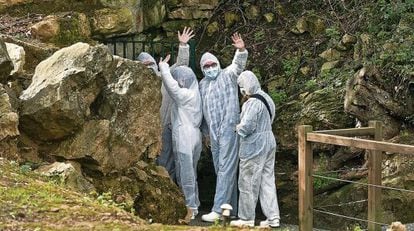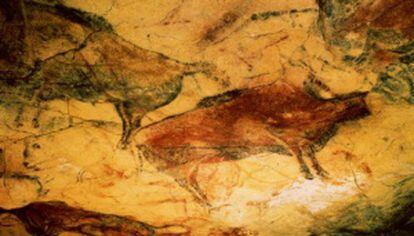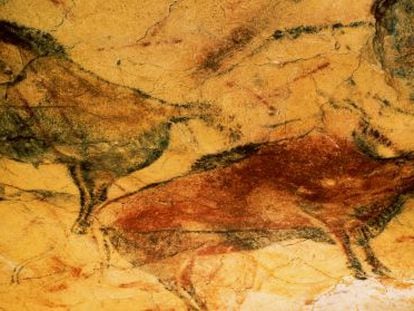Altamira cave will open to visitors
Widely expected decision flouts the majority opinion of prehistoric art experts


The cave of Altamira, a Unesco World Heritage Site and one of the world’s most important examples of prehistoric art, is to be opened for restricted visits for as long as no negative impact is detected.
The site’s board of trustees announced the decision on Thursday afternoon, but it had been widely expected for weeks. A group of academics and scientists had even sent an open letter to Unesco criticizing the likely reopening of Altamira, and describing it as a politically motivated move.
Under the new guidelines, a group of five randomly selected visitors will be allowed into the cave each week for 37 minutes in the company of two guides. This regime has already been tested on an experimental basis over the past year to see what effects it had on the Paleolithic art inside.
Five randomly selected visitors will be allowed into the cave each week for 37 minutes
The decision means that Altamira, located in the northern Spanish region of Cantabria, near the town of Santillana del Mar, will become the only prehistoric cave of its kind to be open to the public in Europe. Similarly significant caves such as Lascaux in France are off limits to visitors, who are instead able to visit recreations of the sites nearby. An accurate recreation of the Altamira caves is situated inside the adjacent museum.
The first group of five visitors will go in on April 10.
Altamira was closed to the public in 2002 after years of tourist visits. Several teams from the CSIC Spanish National Research Council, led by Sergio Sánchez-Moral and Cesáreo Saiz-Jiménez, two of the world’s leading experts on cave art, carried out a survey of the cave between 1996 and 2012, in some cases involving experimental visits. Their preliminary results were published in the journal Science in 2011 and formed the basis of a subsequent report for the Culture Ministry that left no doubt about the dangers posed by visitors: “Any existing threshold of risk has already been crossed,” warned the study.
But in response, in 2012 the ministry commissioned French archeologist Gaël de Guichen to prepare a second report to establish a comprehensive cave preservation plan. This newer report concluded that the cave’s deterioration was due to natural processes, not to the presence of humans.
The importance of the Altamira cave paintings, which are around 18,000 years old and were discovered in 1879, is comparable only to those at Lascaux and Chauvet in southern France. But while all three are Unesco World Heritage Sites, both of the French caves are strictly off limits to visitors – Lascaux because the paintings were nearly lost through deterioration, and Chauvet because it was only found in 1994 and never opened to the public at all.
In January of this year, the prehistory department at Madrid’s Complutense University sent a letter to Unesco criticizing the Spanish Culture Ministry for wanting to reopen the cave, noting that “allowing visitors to the cave raises important questions about its conservation and endangers a fragile legacy of great importance for our understanding of Paleolithic society.”
The open letter, signed by 17 academics, is also supported by around 70 researchers from the CSIC’s History Institute.

“Spain has the obligation to study the cave scientifically and to share any information, as well as to preserve this heritage for future generations,” the letter reads. “The action taken by the Spanish Culture Ministry is a clear threat to its conservation. We believe that Unesco and other international organizations dedicated to preserving cultural heritage should take note of the dangers that political decisions pose for the conservation of Altamira.”
Unesco sent a reply last week, assuring the scholars that it will “follow the matter closely,” said sources at the international organization.
Meanwhile, the Culture Ministry sent a letter of its own to Unesco on Tuesday, stating that “the preventive conservation program has enormously expanded knowledge about the cave and the processes within.”
The letter also claims that researchers found that “the greatest risk and main cause of deterioration of the cave paintings is not, as previously thought, the presence of humans or microbiological activity, but the action of water constantly dripping inside the cave.”
The regional premier of Cantabria, Ignacio Diego, described the letter from the Complutense prehistory department as “an opinion” that was “disrespectful” of the researchers who had drafted the second report.
Most prehistory experts feel that it is dangerous to open up these types of caves
Most of the world’s prehistory experts feel that it is dangerous to open up these types of caves because it could trigger deterioration processes that would only be visible many years down the line. This is what happened in Lascaux.
“I don’t think opening it to the public is the best thing for the conservation of the cave,” said Lawrence Guy Straus, chair of the prehistory department at New Mexico University and director of the Journal of Anthropological Research, who did not take part in either research project.
“It is a unique piece of heritage over 14,000 years old. The more talk there is about opening it and the more it is opened, the more public pressure there will be to open more and more,” he said in a recent interview with EL PAIS. “We need to learn from the lessons of the past. Caves with Paleolithic art are very fragile and you need to be very conservative in their management. That is why there is an excellent replica of Altamira.”
The board of trustees of the Altamira National Museum and Research Center is made up of representatives of the Spanish Culture Ministry, the regional government of Cantabria and the city of Santillana del Mar, as well as the presidents of Cantabria University and Menéndez Pelayo University, the director of the Cantabria Archeology and Prehistory Museum (MUPAC) and the Cantabrian chief of cultural affairs.











































